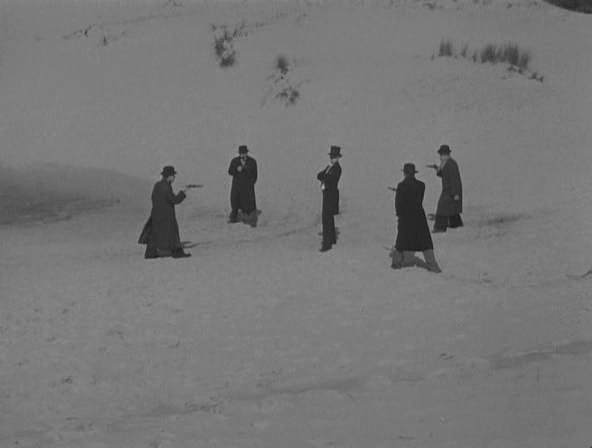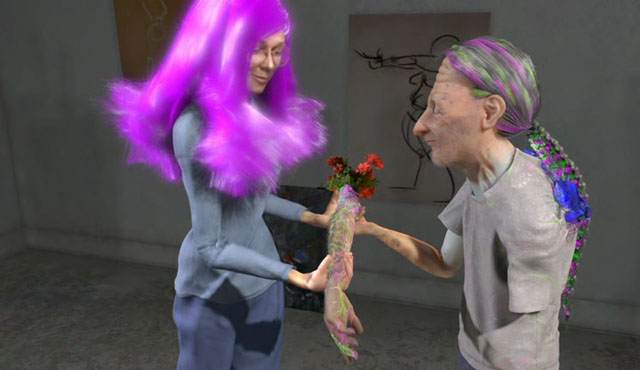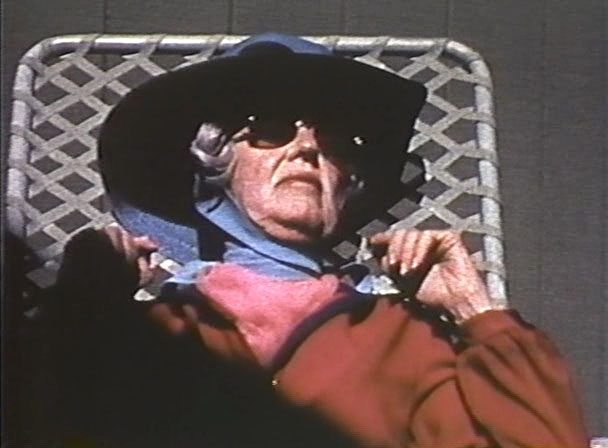Monsieur Fantomas (1937, Ernst Moerman)
This was the prize short of the month… good show, Moerman. Takes the dream-logic, intense crimes and crazy escapes of Feuillade and goes all-out surrealist with them. The master criminal lives in a room with no walls on the beach (much of the movie takes place on the beach), seeks out his true love Elvire. Chief Juve is roused from the bathtub, consults with some seashells and heads buried in the sand. A hundred delightful things happen then it closes with the title card “end of the 280,000th chapter.” Made in Belgium, and I’m very sorry that Moerman didn’t shoot any more films. There really needed to be more surrealist cinema.
The cops close in on Fantomas… but is it really him, or just a cello?

Dinner For One (1963)
Shot in Germany, and shown traditionally every year on television since, a beloved little sketch in which a butler sets the table for an old woman’s absent guests, drinking toasts in each of their places and getting roaring drunk as he continues to perform his duties.
May Warden and Freddie Frinton:

The Spine (2009, Chris Landreth)
Group marital counseling + codependency, slowly coheres into a story. I didn’t like it nearly as much as his short Ryan.

–
Three by Sally Potter
These shorts predate Thriller by almost a decade, early film experiments not having much in common with her features – well, perhaps slightly with The Gold Diggers, which I started watching but haven’t finished.
Hors d’oeuvres (1972)
Silent avant-garde film, a flickering light shines on still photographs, then slow, unstable film footage of one person at a time in a bare room. Dance movements, slowed down then paused, superimpositions, the light pulsating. Lasted about twice as long as my willingness to appreciate it.

Play (1970)
Also silent, two cameras high up at different angles capture the same scenes of children playing on the sidewalk, at first presented side-by-side simulatenously, then re-edited, slowed down and chopped up.

Jerk (1969)
Faces, sped up and extremely rapidly edited. This was my favorite. I wonder if Potter considered the film’s motion to be “jerky” or if she thought this guy was a jerk.

–
Father (1977, Shuji Terayama)
a one-take silent sex scene that turns into a pleasant slideshow, featuring video superimpositions of a hand and the back of a head. No audio on my copy.

La Chambre (1972, Chantal Akerman)
Four slow pans around a cramped apartment, fully silent. First the director flutters her eyes at us from bed, then she is wriggling around, then playing absently with an apple, then – change of camera direction! – eating the apple, as the camera finally realizes she’s the only thing of interest in the room and starts rocking back and forth, homing in on her bed.

Birds Anonymous (1957, Friz Freleng)
“Birds is strictly for the birds.”
Just an average tweety and sylvester short, some kind of parody of werewolf movies and alcoholics anonymous, as far as I can tell. Wonder why this was on my laptop. And what is alum?

Playback (1970, Pere Portabella)
Two cameras, and you can see each in the other’s shot as they circle a composer who is arranging his unconventional choir piece, chattering constantly in unsubtitled Catalan. It’s all kind of exciting. I don’t know anything about Portabella, but I like his shooting style so far.
From the filmmaker’s official site:
Playback is presented as a short rehearsal in a double sense. It is a satellite of the constellation of works that Portabella dedicates to the analysis of the “materiality” of aesthetic and cultural languages (Vampir-Cuadecuc and Miró l’Altre among others can also be understood in this manner). At the same time, he analyzes the rehearsals that Carles Santos carries out for the playback recording of a film on the work of Antoni Gaudi. The choir of the Gran Teatro del Liceu of Barcelona reads fragments from Wagner’s Tannhauser, Lohengrin and the Valkyries. The film was shot in the theater “Lluïsos de Grà cia”.

Two Portraits (1981, Peter Thompson)
The director narrates a series of one-sentence statements about his father, as we see consecutive film frames cross dissolving. “His oldest son died at age 31. The decision to have children was left to his wife, as were all decisions except those concerning money.”
Second portrait is of his mother, filmed sleeping outdoors, while on the audio she reads pages from her diary. The first half was far more illuminating and sympathetic. I’m not sure what to do with the second part, but as with all of Thompson’s films that I’ve seen, I’d be glad to watch it again.
First portrait:

From Chicago Magazine: “When Peter Thompson was 35, his father committed suicide. That tragedy 29 years ago sent the Columbia College professor searching for Super 8 film of his father. He found only 12 seconds’ worth, but stretched them out to 17 minutes and added narration. When he expanded it to include his mother, the resulting film, Two Portraits, moved audiences to tears.”
Second portrait:








































